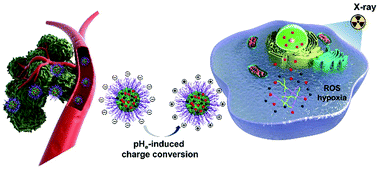Tumor pH-triggered “charge conversion” nanocarriers with on-demand drug release for precise cancer therapy†
Abstract
Combined X-ray-induced photodynamic therapy (X-PDT) and chemotherapy are of great interest for tumor treatment, but their outcome is still hindered by insufficient drug delivery without tumor specificity and the difficulty of switching to chemotherapy during the X-PDT process. Herein, we report an efficient strategy for preparing a nanocarrier, DANPVP&DOX, with slight-acidity-induced charge conversion and hypoxia-motivated doxorubicin (DOX) release properties to achieve a more precise and synchronous therapeutic effect. Upon a change in the extracellular pH (pHe) in the tumor matrix, the surface charge of DANPVP&DOX converted from negative to positive via dimethyl maleate degradation. Following the increased internalization by tumoral cells, exposure of verteporfin (VP) in DANPVP&DOX to low-dose X-ray radiation resulted in O2 consumption in the cytoplasm to produce cytotoxic reactive oxygen species (ROS), which caused cell killing. Moreover, the hypoxic conditions formed in the tumor area specifically promoted DANPVP&DOX dissociation and on-demand DOX release. Consequently, DANPVP&DOX significantly increased the therapeutic efficacy through X-PDT and cascade chemotherapy. More importantly, this strategy could potentially be extended to various therapeutic agents other than anticancer drugs for precise drug delivery and cancer treatment.



 Please wait while we load your content...
Please wait while we load your content...